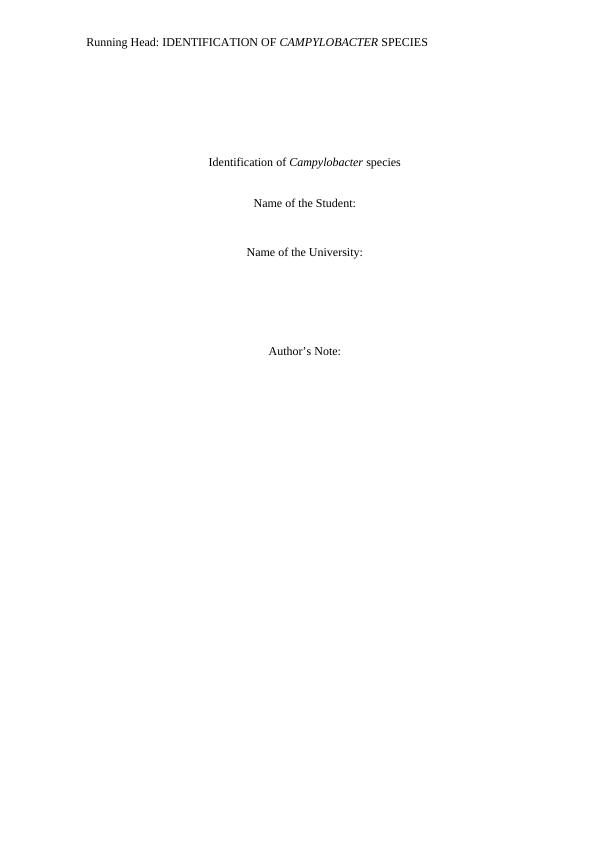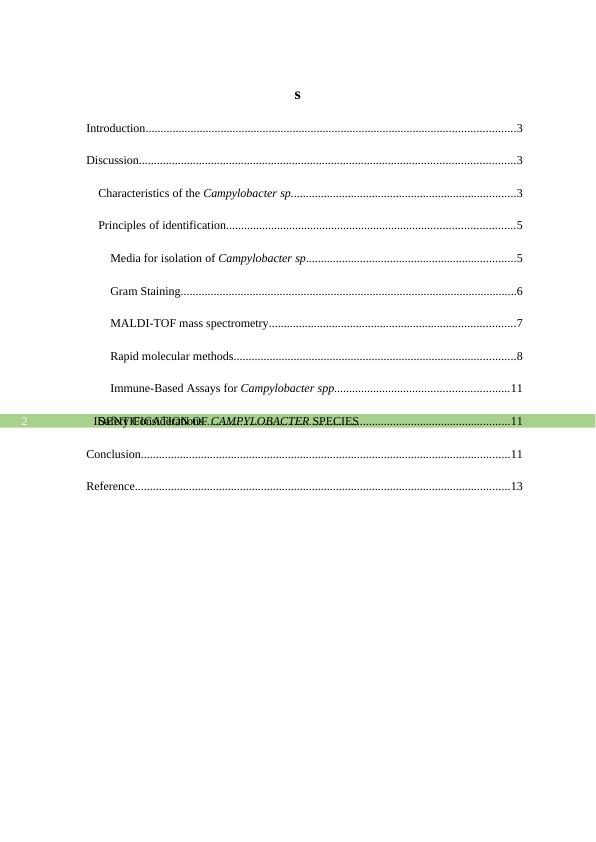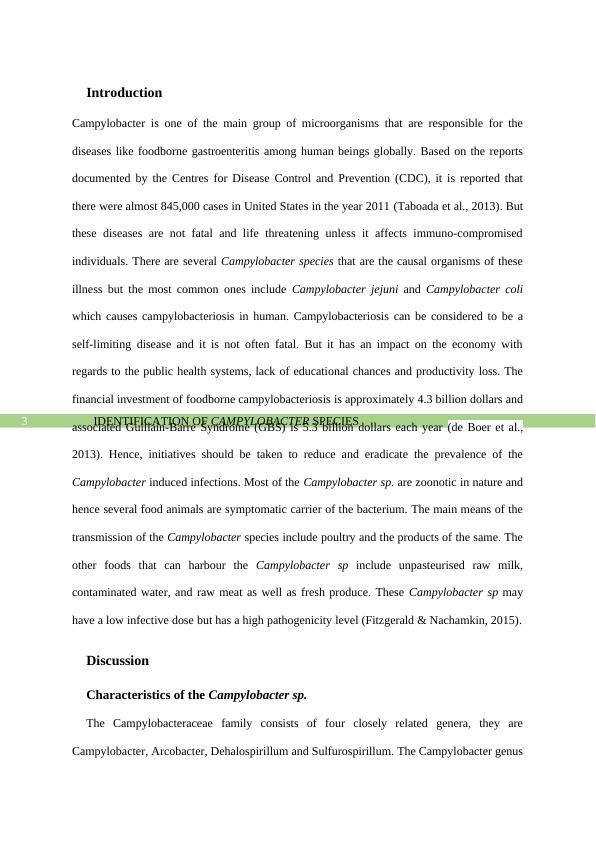Identification of Campylobacter species
Added on 2022-11-13
17 Pages4158 Words129 Views
Running Head: IDENTIFICATION OF CAMPYLOBACTER SPECIES
Identification of Campylobacter species
Name of the Student:
Name of the University:
Author’s Note:
Identification of Campylobacter species
Name of the Student:
Name of the University:
Author’s Note:

IDENTIFICATION OF CAMPYLOBACTER SPECIES1
Abstract
Campylobacter spp. is considered to be one of the causal organisms of bacterial
gastroenteritis that is often isolated from the poultry animal as well as the environmental
samples. The gastroenteritis caused by Campylobacter is especially common in the children
in their first five years. According to the statistical studies it contributes to about 46% of the
infection. It is considered that this is not a fatal life-threatening disease unless the individual
is immunocompromised. But this frequent prevalence of the disease impacts the revenue due
to the investments by the public health systems, loss in productivity and the lack of
opportunity for education. Thus, initiatives should be taken to prevent and eradicate the
occurrence of campylobacteriosis. The most common species that are involved in the
infections are Campylobacter jejuni and Campylobacter coli. These pathogens are zoonotic in
nature. This article covers the ways by which the pathogens can be easily detected so that
appropriate prevention strategies can be implemented. It can be transmitted through poultry
and less frequently through raw unpasteurized milk, raw meat and contaminated water. There
are various identification techniques like the conventional culturing methods and the
biochemical tests as well as the Gram staining. But these techniques are time consuming and
laborious. The detection of the species should be rapid as well as accurate to reduce and
prevent the foodborne illness. Various molecular methods consists of enhanced diagnostic
capabilities. These are comparatively more rapid, sensitive and specific.
Table of Content
Abstract
Campylobacter spp. is considered to be one of the causal organisms of bacterial
gastroenteritis that is often isolated from the poultry animal as well as the environmental
samples. The gastroenteritis caused by Campylobacter is especially common in the children
in their first five years. According to the statistical studies it contributes to about 46% of the
infection. It is considered that this is not a fatal life-threatening disease unless the individual
is immunocompromised. But this frequent prevalence of the disease impacts the revenue due
to the investments by the public health systems, loss in productivity and the lack of
opportunity for education. Thus, initiatives should be taken to prevent and eradicate the
occurrence of campylobacteriosis. The most common species that are involved in the
infections are Campylobacter jejuni and Campylobacter coli. These pathogens are zoonotic in
nature. This article covers the ways by which the pathogens can be easily detected so that
appropriate prevention strategies can be implemented. It can be transmitted through poultry
and less frequently through raw unpasteurized milk, raw meat and contaminated water. There
are various identification techniques like the conventional culturing methods and the
biochemical tests as well as the Gram staining. But these techniques are time consuming and
laborious. The detection of the species should be rapid as well as accurate to reduce and
prevent the foodborne illness. Various molecular methods consists of enhanced diagnostic
capabilities. These are comparatively more rapid, sensitive and specific.
Table of Content

IDENTIFICATION OF CAMPYLOBACTER SPECIES2
s
Introduction...........................................................................................................................3
Discussion.............................................................................................................................3
Characteristics of the Campylobacter sp...........................................................................3
Principles of identification................................................................................................5
Media for isolation of Campylobacter sp......................................................................5
Gram Staining................................................................................................................6
MALDI-TOF mass spectrometry..................................................................................7
Rapid molecular methods..............................................................................................8
Immune-Based Assays for Campylobacter spp..........................................................11
Safety Considerations......................................................................................................11
Conclusion...........................................................................................................................11
Reference.............................................................................................................................13
s
Introduction...........................................................................................................................3
Discussion.............................................................................................................................3
Characteristics of the Campylobacter sp...........................................................................3
Principles of identification................................................................................................5
Media for isolation of Campylobacter sp......................................................................5
Gram Staining................................................................................................................6
MALDI-TOF mass spectrometry..................................................................................7
Rapid molecular methods..............................................................................................8
Immune-Based Assays for Campylobacter spp..........................................................11
Safety Considerations......................................................................................................11
Conclusion...........................................................................................................................11
Reference.............................................................................................................................13

IDENTIFICATION OF CAMPYLOBACTER SPECIES3
Introduction
Campylobacter is one of the main group of microorganisms that are responsible for the
diseases like foodborne gastroenteritis among human beings globally. Based on the reports
documented by the Centres for Disease Control and Prevention (CDC), it is reported that
there were almost 845,000 cases in United States in the year 2011 (Taboada et al., 2013). But
these diseases are not fatal and life threatening unless it affects immuno-compromised
individuals. There are several Campylobacter species that are the causal organisms of these
illness but the most common ones include Campylobacter jejuni and Campylobacter coli
which causes campylobacteriosis in human. Campylobacteriosis can be considered to be a
self-limiting disease and it is not often fatal. But it has an impact on the economy with
regards to the public health systems, lack of educational chances and productivity loss. The
financial investment of foodborne campylobacteriosis is approximately 4.3 billion dollars and
associated Guillain-Barre Syndrome (GBS) is 5.3 billion dollars each year (de Boer et al.,
2013). Hence, initiatives should be taken to reduce and eradicate the prevalence of the
Campylobacter induced infections. Most of the Campylobacter sp. are zoonotic in nature and
hence several food animals are symptomatic carrier of the bacterium. The main means of the
transmission of the Campylobacter species include poultry and the products of the same. The
other foods that can harbour the Campylobacter sp include unpasteurised raw milk,
contaminated water, and raw meat as well as fresh produce. These Campylobacter sp may
have a low infective dose but has a high pathogenicity level (Fitzgerald & Nachamkin, 2015).
Discussion
Characteristics of the Campylobacter sp.
The Campylobacteraceae family consists of four closely related genera, they are
Campylobacter, Arcobacter, Dehalospirillum and Sulfurospirillum. The Campylobacter genus
Introduction
Campylobacter is one of the main group of microorganisms that are responsible for the
diseases like foodborne gastroenteritis among human beings globally. Based on the reports
documented by the Centres for Disease Control and Prevention (CDC), it is reported that
there were almost 845,000 cases in United States in the year 2011 (Taboada et al., 2013). But
these diseases are not fatal and life threatening unless it affects immuno-compromised
individuals. There are several Campylobacter species that are the causal organisms of these
illness but the most common ones include Campylobacter jejuni and Campylobacter coli
which causes campylobacteriosis in human. Campylobacteriosis can be considered to be a
self-limiting disease and it is not often fatal. But it has an impact on the economy with
regards to the public health systems, lack of educational chances and productivity loss. The
financial investment of foodborne campylobacteriosis is approximately 4.3 billion dollars and
associated Guillain-Barre Syndrome (GBS) is 5.3 billion dollars each year (de Boer et al.,
2013). Hence, initiatives should be taken to reduce and eradicate the prevalence of the
Campylobacter induced infections. Most of the Campylobacter sp. are zoonotic in nature and
hence several food animals are symptomatic carrier of the bacterium. The main means of the
transmission of the Campylobacter species include poultry and the products of the same. The
other foods that can harbour the Campylobacter sp include unpasteurised raw milk,
contaminated water, and raw meat as well as fresh produce. These Campylobacter sp may
have a low infective dose but has a high pathogenicity level (Fitzgerald & Nachamkin, 2015).
Discussion
Characteristics of the Campylobacter sp.
The Campylobacteraceae family consists of four closely related genera, they are
Campylobacter, Arcobacter, Dehalospirillum and Sulfurospirillum. The Campylobacter genus

End of preview
Want to access all the pages? Upload your documents or become a member.
